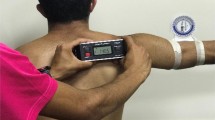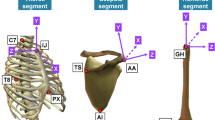Abstract
The aim of this study is to investigate the effects of scapular taping on scapular kinematics by three-dimensional electromagnetic system during shoulder elevation in facioscapulohumeral muscular dystrophy patients. A total of 11 patients with facioscapulohumeral muscular dystrophy were included in the study. Scapular anterior-posterior tilt, upward-downward rotation, and internal-external rotations were evaluated using the three-dimensional electromagnetic system during the elevation of the upper limbs in the scapular plane before and after kinesio taping. For maximum humerothoracic elevation, there were no differences between the patients before and after taping on both dominant (p = 0.72) and non-dominant sides (p = 0.64). For scapular internal rotation, upward rotation, and posterior tilt, there were no differences between patients before and after taping during humerothoracic elevation on both dominant and non-dominant sides (p > 0.05). These results showed us that the excessive and abnormal movements of the scapula observed during the humeral elevation in facioscapulohumeral muscular dystrophy patients cannot be supported with flexible methods like kinesio taping. Therefore, we recommend to evaluate the scapula position by applying flexible and rigid taping to the patients who can reach over 90o in humerothoracic elevation in future studies.


Similar content being viewed by others
Change history
10 May 2019
The published version of this article unfortunately contained a mistake in Fig. 2. Only one graphic of different movement of scapula was published instead of three. The Figure is corrected here.
References
Fitzsimons R (1999) Facioscapulohumeral muscular dystrophy. Curr Opin Neurol 12(5):501–511
Filippelli E, Barone S, Granata A, Nisticò R, Valentino P (2019) A case of facioscapulohumeral muscular dystrophy and myasthenia gravis with positivity of anti-Ach receptor antibody: a fortuitous association? Neurol Sci 40(1):195–197
Mummery CJ, Copeland S, Rose MR (2003) Scapular fixation in muscular dystrophy. Cochrane Database Syst Rev 3
Kılınç M, Atay S, Aksu S, Tan E Nöromusküler hastalıklarda ağrının yaşam kalitesi üzerine etkisi: pilot çalışma
Orrell RW, Copeland S, Rose MR (2010) Scapular fixation in muscular dystrophy. The Cochrane Library
Alsancak S, Altinkaynak H, Kinik H (2001) Scapulothoracic fixation orthosis for facioscapulohumeral dystrophy. J Prosthet Orthot 12(4):106–109
McGovern D, Rahman S, Lavezzo M, Dozier L (2008) Case report: scapulothoracic orthosis for winging scapula. J Prosthet Orthot 20(1):14–18
Giannini S, Faldini C, Pagkrati S, Grandi G, Digennaro V, Luciani D, Merlini L (2007) Fixation of winged scapula in facioscapulohumeral muscular dystrophy. Clin Med Res 5(3):155–162
Hsu Y-H, Chen W-Y, Lin H-C, Wang WT, Shih Y-F (2009) The effects of taping on scapular kinematics and muscle performance in baseball players with shoulder impingement syndrome. J Electromyogr Kinesiol 19(6):1092–1099
Williams S, Whatman C, Hume PA, Sheerin K (2012) Kinesio taping in treatment and prevention of sports injuries. Sports Med 42(2):153–164
Huang C-Y, Hsieh T-H, Lu S-C, Su F-C (2011) Effect of the Kinesio tape to muscle activity and vertical jump performance in healthy inactive people. Biomed Eng Online 10(1):70
Aguilar-Ferrándiz ME, Castro-Sánchez AM, Matarán-Peñarrocha GA, García-Muro F, Serge T, Moreno-Lorenzo C (2013) Effects of kinesio taping on venous symptoms, bioelectrical activity of the gastrocnemius muscle, range of ankle motion, and quality of life in postmenopausal women with chronic venous insufficiency: a randomized controlled trial. Arch Phys Med Rehabil 94(12):2315–2328
Shah M, Julu P, Monro J, Coutinho J, Ijeh C, Puri B (2018) Neuromuscular taping reduces blood pressure in systemic arterial hypertension. Med Hypotheses 116:30–32
Castrogiovanni P, Di Giunta A, Guglielmino C, Roggio F, Romeo D, Fidone F, Imbesi R, Loreto C, Castorina S, Musumeci G (2016) The effects of exercise and kinesio tape on physical limitations in patients with knee osteoarthritis. J Funct Morphol Kinesiol 1(4):355–368
Borzì F, Szychlinska M, Di Rosa M, Musumeci G (2018) A short overview of the effects of Kinesio taping for postural spine curvature disorders. J Funct Morphol Kinesiol 3(4):59
Shih Y-F, Lee Y-F, Chen W-Y (2018) Effects of Kinesiology taping on scapular reposition accuracy, kinematics, and muscle activity in athletes with shoulder impingement syndrome-a randomized controlled study. J Sport Rehabil:1–32
Turgut E, Ayhan C, Baltaci G (2017) Repositioning the scapula with taping following distal radius fracture: kinematic analysis using 3-dimensional motion system. J Hand Ther 30(4):477–482
Zanca GG, Grüninger B, Mattiello SM (2016) Effects of Kinesio taping on scapular kinematics of overhead athletes following muscle fatigue. J Electromyogr Kinesiol 29:113–120
Kaya Kara O, Atasavun Uysal S, Turker D, Karayazgan S, Gunel MK, Baltaci G (2015) The effects of Kinesio taping on body functions and activity in unilateral spastic cerebral palsy: a single-blind randomized controlled trial. Dev Med Child Neurol 57(1):81–88
Jaraczewska E, Long C (2006) Kinesio® taping in stroke: improving functional use of the upper extremity in hemiplegia. Top Stroke Rehabil 13(3):31–42
Tamburella F, Scivoletto G, Molinari M (2014) Somatosensory inputs by application of KinesioTaping: effects on spasticity, balance, and gait in chronic spinal cord injury. Front Hum Neurosci 8:367
Capecci M, Serpicelli C, Fiorentini L, Censi G, Ferretti M, Orni C, Renzi R, Provinciali L, Ceravolo MG (2014) Postural rehabilitation and Kinesio taping for axial postural disorders in Parkinson's disease. Arch Phys Med Rehabil 95(6):1067–1075
Cortesi M, Cattaneo D, Jonsdottir J (2011) Effect of kinesio taping on standing balance in subjects with multiple sclerosis: a pilot study\m {1}. NeuroRehabilitation 28(4):365–372
Shaheen AF, Villa C, Lee Y-N, Bull AM, Alexander CM (2013) Scapular taping alters kinematics in asymptomatic subjects. J Electromyogr Kinesiol 23(2):326–333
Thigpen CA, Padua DA, Morgan N, Kreps C, Karas SG (2006) Scapular kinematics during supraspinatus rehabilitation exercise: a comparison of full-can versus empty-can techniques. Am J Sports Med 34(4):644–652
Turgut E, Duzgun I, Baltaci G (2016) Scapular asymmetry in participants with and without shoulder impingement syndrome; a three-dimensional motion analysis. Clin Biomech 39:1–8
Wu G, Van der Helm FC, Veeger HD, Makhsous M, Van Roy P, Anglin C, Nagels J, Karduna AR, McQuade K, Wang X (2005) ISB recommendation on definitions of joint coordinate systems of various joints for the reporting of human joint motion—part II: shoulder, elbow, wrist and hand. J Biomech 38(5):981–992
Sciascia A, Thigpen C, Namdari S, Baldwin K (2012) Kinetic chain abnormalities in the athletic shoulder. Sports Med Arthrosc Rev 20(1):16–21
Demirci CS, Turgut E, Ayvat E, Onursal Ö, Ayvat F, Yıldız T, Düzgün İ, Kılınç M, Yıldırım SA (2018) Kinematic analysis of scapular movements in patients with facioscapulohumeral muscular dystrophy. J Electromyogr Kinesiol 38:88–93
Rijken N, van der Kooi E, Hendriks J, van Asseldonk R, Padberg G, Geurts A, van Engelen B (2014) Skeletal muscle imaging in facioscapulohumeral muscular dystrophy, pattern and asymmetry of individual muscle involvement. Neuromuscul Disord 24(12):1087–1096
Tasca G, Monforte M, Iannaccone E, Laschena F, Ottaviani P, Leoncini E, Boccia S, Galluzzi G, Pelliccioni M, Masciullo M (2014) Upper girdle imaging in facioscapulohumeral muscular dystrophy. PLoS One 9(6):e100292
Ben Kibler W (1998) The role of the scapula in athletic shoulder function. Am J Sports Med 26(2):325–337
Van Herzeele M, van Cingel R, Maenhout A, De Mey K, Cools A (2013) Does the application of kinesiotape change scapular kinematics in healthy female handball players? Int J Sports Med 34(11):950–955
Author information
Authors and Affiliations
Corresponding author
Ethics declarations
Conflict of interest
The authors declare that they have no conflict of interest.
Additional information
Publisher’s note
Springer Nature remains neutral with regard to jurisdictional claims in published maps and institutional affiliations.
Rights and permissions
About this article
Cite this article
Savcun Demirci, C., Onursal Kılınç, Ö., Yıldız, T.İ. et al. Effect of taping on scapular kinematics of patients with facioscapulohumeral muscular dystrophy. Neurol Sci 40, 1583–1588 (2019). https://doi.org/10.1007/s10072-019-03846-y
Received:
Accepted:
Published:
Issue Date:
DOI: https://doi.org/10.1007/s10072-019-03846-y




